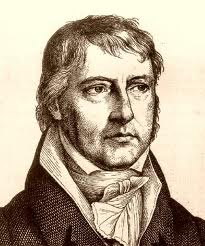22ND LECTURE AT THE GRAMSCI MONUMENT, THE BRONX, NYC: 22ND JULY 2013 WHAT PHILOSOPHY IS MARCUS STEINWEG

G.W.F. Hegel
From the outset philosophy has caused anxiety. What caused the anxiety was the lack of anxiety, philosophy's courage, because philosophy is a movement full of risks. It is a movement of love (philía, philein) requiring courage and resolve. People have tried to subject it to ridicule. People were scared of the philosopher as the dark one (skoteinós). People mocked the philosopher because, instead of seeing what was close to hand, he only saw what was remote so that he would only fall into a well or continually stumble. People accused him of seducing the youth of Athens and brought him to trial and, occasionally, they killed him. I define philosophy as the courage not to evade the call of the great concepts: What is freedom, what is truth, what is justice, what is love, what is the human being? And how do these questions stand in relation to art and philosophy?
I think that art and philosophy share this courage. Art is an assertion of form in the opening toward formlessness; philosophy is the assertion of truth within the intransparency of instituted realities. Art's assertion of form, philosophy's assertion of truth demand a confrontation with these realities without bending to them. Art and philosophy exist only in autonomy and resistance to what is established. The autonomy and resistance of art and philosophy cannot be scientifically proven; they must be asserted through works eluding the dictates of provability whilst constituting the autono- my of the artwork. That work is autonomous which maintains a resistant autonomy vis-à-vis the imperatives of the Zeitgeist: the freedom of its form. The formalism of freedom which art is releases the work from its history, from the domain of its real cultural as well as technical, historical, informational and economic determination. The work relates to its determinants without conceding them a final authority over it, because it implies an assertion which ties it to the impossible, to its truth which does not belong to this domain (or only as its absolute limit). Autonomy is the name for the work's irreducibility, for the opposition of an assertion which overflies, surpasses its own conditions. Through its autonomy, the work maintains its relation to the infinite. The infinite is yet another name for the incommensurable. In contact with it, there can be a certain autonomy for the artwork which liberates it from the clutches of its determinants.
In the history of philosophy, chaos has many names. It is the divine, the noumenal and the sublime, the untimely, the uncanny, nothingness or freedom, the infinite, becoming or the exterior, contingency and pure multiplicity, the dimension of the ethical, of the mystical, of the miracle and the unspeakable: the incommensurable, the heterogeneous, the impossible: pure facelessness and namelessness. So many names for the one namelessness. I think that they are so numerous and so contradictory (why should contingency and freedom belong to the same arrangement?) because they refer to the conflict-ridden fundamental assertion of Western thinking that the beyond of the world of established realities can only be thought as something impossible and unliveable. The difficulty lies in the fact of having to concede its incompetence in the act of touching the impossible. Thinking is a thinking of the unthinkable; otherwise it would not be philosophy. The positive concept of the subject comprises an openness to the non-positive and untouchable. Agreement with its ontological incompetence would be an act of self-affirmation of a subject that refuses to capitulate to nothingness.
Nothingness is the philosophical name for this abyss of the untouchable which Hegel calls the "night of the world", the emptiness implicit within the subject, absolute negativity. Therefore it is sensibleto insist on art and philosophy as appearances ex nihilo because they are effects of touching the untouchable, of touching nothingness. It has to be understood that the fact that nothing comes from nothing does not represent any contradiction to truth ex nihilo because what is here called nothingness, as in Hegel's "night of the world", is both total emptiness and excessive richness. Hegelian thinking knows of a certain equivalence for this overly abundant nothingness: that is the incommensurable, still undetermined substance. The fact that "substance is essentially subject" means also that substance marks the abysmal ground of the subject, the infinite inherent within it which articulates itself in the form of the subject. A subject is what helps substance, nothingness come to being, to appearance. The sphere of substance is not the universe of the universalia underlying its ontic-phenomenological manifestation. It is, like the night of the world, a zone of ontological tornness, a chaotic space of acosmic indifference.
